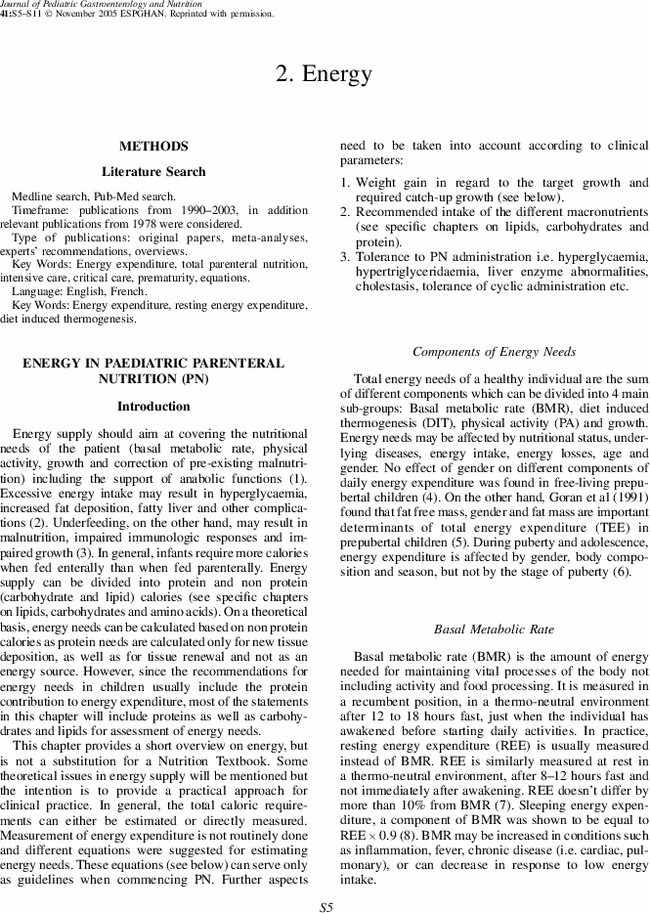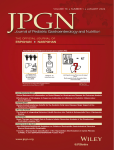Article
2. Energy
Correction(s) for this article
-
Energy
- Volume 56Issue 4Journal of Pediatric Gastroenterology and Nutrition
- pages: 460-460
- First Published online: April 1, 2013

REFERENCES
- 1Elia M. Changing concepts of nutrient requirements in disease: implications for artificial nutritional support. Lancet 1995; 345: 1279–84.
- 2Sheldon GF, Peterson SR, Sanders R. Hepatic dysfunction during hyperalimentation. Arch Surg 1978; 113: 504–8.
- 3Torun B, Chew F. Protein-energy malnutrition. In: M Shils, M Shike, J Olson, et al. Modern nutrition in health and disease. Baltimore: Williams & Wilkins, Media, PA; 1999: 963–88.
- 4Grund A, Vollbrecht H, Frandsen W, et al. No effect of gender on different components of daily energy expenditure in free living prepubertal children. Int J Obes Relat Metab Disord 2000; 24: 299–305.
- 5Goran MI, Kaskoun M, Johnson R. Determinants of resting energy expenditure in young children. J Pediatr 1994; 125: 362–7.
- 6Bitar A, Fellmann N, Vernet J, et al. Variations and determinants of energy expenditure as measured by whole-body indirect calorimetry during puberty and adolescence. Am J Clin Nutr 1999; 69: 1209–16.
- 7Shulman RJ, Phillips S. Parenteral nutrition in infants and children. J Pediatr Gastroenterol Nutr 2003; 36: 587–60.
- 8Beghin L, Michaud L, Guimber D, et al. Assessing sleeping energy expenditure in children using heart-rate monitoring calibrated against open-circuit indirect calorimetry: a pilot study. Br J Nutr 2002; 88: 533–43.
- 9Romon M, Edme JL, Boulenguez C, et al. Circadian variation of diet-induced thermogenesis. Am J Clin Nutr 1993; 57: 476–80.
- 10Just B, Messing B, Darmaun D, et al. Comparison of substrate utilization by indirect calorimetry during cyclic and continuous total parenteral nutrition. Am J Clin Nutr 1990; 51: 107–11.
- 11Lerebours E, Rimbert A, Hecketsweiler B, et al. Comparison of the effects of continuous and cyclic nocturnal parenteral nutrition on energy expenditure and protein metabolism. JPEN J Parenter Enteral Nutr 1988; 12: 360–4.
- 12Putet G, Bresson JL, Ricour C. Exclusive parenteral nutrition in children. Influence of continuous or cyclic intake on the utilization of food. [Article in French]. Arch Fr Pediatr 1984; 41: 111–5.
- 13Beghin L, Michaud L, Hankard R, et al. Total energy expenditure and physical activity in children treated with home parenteral nutrition. Pediatr Res 2003; 53: 684–90.
- 14 WHO. World Health Organization. Energy and protein requirements, Report of a joint FAO/WHO/UNU expert consultation. Geneva: World Health Organization; 1985.
- 15Torun B, Davies PS, Livingstone MB, et al. Energy requirements and dietary energy recommendations for children and adolescents 1 to 18 years old. Eur J Clin Nutr 1996; 50: S37–80.
- 16Wells JC, Davies PS. Can body size predict infant energy requirements? Arch Dis Child 1999; 81: 429–30.
- 17Cunningham JJ. Body composition as a determinant of energy expenditure: a synthetic review and a proposed general prediction equation. Am J Clin Nutr 1991; 54: 963–9.
- 18Gallagher D, Belmonte D, Deurenberg P, et al. Organ-tissue mass measurement allows modeling of REE and metabolically active tissue mass. Am J Physiol 1998; 275: E249–58.
- 19Wells JC. Energy metabolism in infants and children. Nutrition 1998; 14: 817–20.
- 20Strath SJ, Bassett DR, Thompson DL, et al. Validity of the simultaneous heart rate-motion sensor technique for measuring energy expenditure. Med Sci Sports Exerc 2002; 34: 888–94.
- 21Beghin L, Budniok T, Vaksman G, et al. Simplification of the method of assessing daily and nightly energy expenditure in children, using heart rate monitoring calibrated against open circuit indirect calorimetry. Clin Nutr 2000; 19: 425–35.
- 22Ekelund U, Sjostrom M, Yngve A, et al. Physical activity assessed by activity monitor and doubly labeled water in children. Med Sci Sports Exerc 2001; 33: 275–81.
- 23Harris JA, Benedict FG. A biometric study of basal metabolism in man. Washington, D.C.: Carnegie Institute of Washington; 1919.
- 24Schofield WN. Predicting basal metabolic rate, new standards and review of previous work. Hum Nutr Clin Nutr 1985; 39: 5–41.
- 25Duro D, Rising R, Cole C, et al. New equations for calculating the components of energy expenditure in infants. J Pediatr 2002; 140: 534–9.
- 26Thomson MA, Bucolo S, Quirk P, et al. Measured versus predicted resting energy expenditure in infants: a need for reappraisal. J Pediatr 1995; 126: 21–7.
- 27Kaplan AS, Zemel BS, Neiswender KM, et al. Resting energy expenditure in clinical pediatrics: measured versus prediction equations. J Pediatr 1995; 127: 200–5.
- 28Sentongo TA, Tershakovec AM, Mascarenhas MR, et al. Resting energy expenditure and prediction equations in young children with failure to thrive. J Pediatr 2000; 136: 345–50.
- 29Daly JM, Heymsfield SB, Head CA, et al. Human energy requirements: overestimation by widely used prediction equation. Am J Clin Nutr 1985; 42: 1170–4.
- 30Rodriguez G, Moreno LA, Sarria A, et al. Resting energy expenditure in children and adolescents: agreement between calorimetry and prediction equations. Clin Nutr 2002; 21: 255–60.
- 31Firouzbakhsh S, Mathis RK, Dorchester WL, et al. Measured resting energy expenditure in children. J Pediatr Gastroenterol Nutr 1993; 16: 136–42.
- 32Koretz RL, Lipman TO, Klein S, et al. AGA technical review on parenteral nutrition. Gastroenterology 2001; 121: 970–1001.
- 33Wilson DC, Cairns P, Halliday HL, et al. Randomised controlled trial of an aggressive nutritional regimen in sick very low birthweight infants. Arch Dis Child Fetal Neonatal Ed 1997; 77: F4–11.
- 34Thureen PJ, Hay WW. Intravenous nutrition and postnatal growth of the micropremie. Clin Perinatol 2000; 27: 197–219.
- 35Lloyd DA. Energy requirements of surgical newborn infants receiving parenteral nutrition. Nutrition 1998; 14: 101–4.
- 36Garza JJ, Shew SB, Keshen TH, et al. Energy expenditure in ill premature neonates. J Pediatr Surg 2002; 37: 289–93.
- 37Carr B, Denne S, Leitch C. Total energy expenditure in extremely premature and term infants in early postnatal life. Pediatr Res 2000; 47: 284A.
- 38Ziegler EE, O'Donnell AM, Nelson SE, et al. Body composition of the reference fetus. Growth 1976; 40: 329–41.
- 39Leitch CA, Ahlrichs J, Karn C, et al. Energy expenditure and energy intake during dexamethasone therapy for chronic lung disease. Pediatr Res 1999; 46: 109–13.
- 40White MS, Shepherd RW, McEniery JA. Energy expenditure measurements in ventilated critically ill children: within- and between-day variability. JPEN J Parenter Enteral Nutr 1999; 23: 300–4.
- 41Chwals WJ, Lally KP, Woolley MM, et al. Measured energy expenditure in critically ill infants and young children. J Surg Res 1988; 44: 467–72.
- 42Briassoulis G, Venkataraman S, Thompson AE. Energy expenditure in critically ill children. Crit Care Med 2000; 28: 1166–72.
- 43Cheng CH, Chen CH, Wong Y, et al. Measured versus estimated energy expenditure in mechanically ventilated critically ill patients. Clin Nutr 2002; 21: 165–72.
- 44White MS, Shepherd RW, McEniery JA. Energy expenditure in 100 ventilated, critically ill children: improving the accuracy of predictive equations. Crit Care Med 2000; 28: 2307–12.
- 45Coss-Bu JA, Klish WJ, Walding D, et al. Energy metabolism, nitrogen balance, and substrate utilization in critically ill children. Am J Clin Nutr 2001; 74: 664–9.
- 46Coss-Bu JA, Jefferson LS, Walding D, et al. Resting energy expenditure in children in a pediatric intensive care unit: comparison of Harris-Benedict and Talbot predictions with indirect calorimetry values. Am J Clin Nutr 1998; 67: 74–80.
- 47Chwals WJ. Overfeeding the critically ill child: fact or fantasy? New Horiz 1994; 2: 147–55.
- 48Joosten KF, Verhoeven JJ, Hazelzet JA. Energy expenditure and substrate utilization in mechanically ventilated children. Nutrition 1999; 15: 444–8.
- 49Powis MR, Smith K, Rennie M, et al. Effect of major abdominal operations on energy and protein metabolism in infants and children. J Pediatr Surg 1998; 33: 49–53.
- 50Jones MO, Pierro A, Hammond P, et al. The metabolic response to operative stress in infants. J Pediatr Surg 1993; 28: 1258–62.
- 51Pierro A, Jones MO, Hammond P, et al. A new equation to predict the resting energy expenditure of surgical infants. J Pediatr Surg 1994; 29: 1103–8.
- 52Matthews DS, Aynsley-Green A, Matthews JN, et al. The effect of severe head injury on whole body energy expenditure and its possible hormonal mediators in children. Pediatr Res 1995; 37: 409–17.
- 53Phillips R, Ott L, Young B, et al. Nutritional support and measured energy expenditure of the child and adolescent with head injury. J Neurosurg 1987; 67: 846–51.
- 54McCall M, Jeejeebhoy K, Pencharz P, et al. Effect of neuromuscular blockade on energy expenditure in patients with severe head injury. JPEN J Parenter Enteral Nutr 2003; 27: 27–35.
- 55Tokutomi T, Morimoto K, Miyagi T, et al. Optimal temperature for the management of severe traumatic brain injury: effect of hypothermia on intracranial pressure, systemic and intracranial hemodynamics, and metabolism. Neurosurgery 2003; 52: 102–11.
- 56Dickerson RN, Brown RO, Hanna DL, et al. Validation of a new method for estimating resting energy expenditure of non-ambulatory tube-fed patients with severe neurodevelopmental disabilities. Nutrition 2002; 18: 578–82.
- 57Goran MI, Broemeling L, Herndon DN, et al. Estimating energy requirements in burned children: a new approach derived from measurements of resting energy expenditure. Am J Clin Nutr 1991; 54: 35–40.
- 58Ringwald-Smith KA, Heslop HE, Krance RA, et al. Energy expenditure in children undergoing hematopoietic stem cell transplantation. Bone Marrow Transplant 2002; 30: 125–30.
- 59Duggan C, Bechard L, Donovan K, et al. Changes in resting energy expenditure among children undergoing allogeneic stem cell transplantation. Am J Clin Nutr 2003; 78: 104–9.
- 60Herndon DN, Hart DW, Wolf SE, et al. Reversal of catabolism by beta-blockade after severe burns. N Engl J Med 2001; 345: 1223–9.




